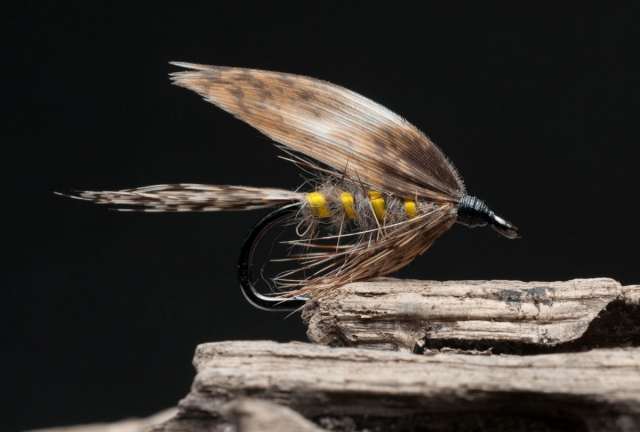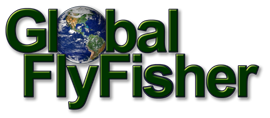Books that formed me
...as a fly tyer and flyfisher, that is. Other books influenced me as a person, but that’s a whole other story.
I started reading fishing books fairly early in my “fishing career”, maybe even before I started fishing seriously, and books soon became an important part of my tying and fishing when I took it up on a more regular basis.
The first book I ever encountered about fishing belonged to my father. He fly-fished, but never managed to pass the interest on to me. My interest in fishing – and fly-fishing in particular – came after I had moved from home and started studying biology at the University of Copenhagen.
Back to the books.
We had many books in my childhood home, and in my parents' bookshelves there were a handful of books that I found very intriguing and often spent time reading. They were part of a series of Danish books called “Politiken’s Handbooks”, which were published by a publishing company run by the large Copenhagen newspaper called “Politiken” (The Policy).
These handbooks had been published for decades already when I was born (in 1959), and the series counted dozens and dozens of titles. Among the ones that had my attention was my father’s copy of “I’m a fisherman” (in Danish: “Jeg er lystfisker”), which is in my possession now.
These handbooks were
the “jack of all trades, master of none” kind of books. They covered essentially all aspects of their subjects, and in the case of fishing that meant clothing, boating, motors, deep sea fishing, stream fishing for trout and grayling, tuna fishing (yup, we had tuna fishing right outside of Copenhagen harbor!) as well as locations to go – including fishing in Greenland. This was 99% spin and bait fishing, and just a few pages about fly fishing. I wasn’t a fly fisherman at the time – hardly a fisherman at all, actually – and fishing was fishing, end of story.
I also had books in the series on being a “Tape Recorder Amateur” and one on model airplanes as well as one on general hobbies – including fishing covered in a dozen pages or so. I loved them all.
My father also owned Walton’s “The Compleat Angler” in a Danish translation. I also own his copy today, but I didn’t read it as a child or a teen. It’s a bit more demanding than the very superficial and illustrated handbooks, and I first read it in its entirety later in my fishing career – and was delighted.
When I started
fishing more seriously, I also started looking for more books. My day-to-day fishing was (and still is) coastal fishing for sea run brown trout (sea trout), and the relevant book titles on this subject were fairly few. But during a family holiday about 30 years ago, I stumbled over Danish Jan Grünwald’s “Sea Trout - Spin and Fly in Saltwater” (In Danish: “Havørred - spin og flue i saltvand”) in a small, local bookstore in the town where we spent our vacation.
I can very firmly say that this has been the most influential fishing book I ever owned. It had a huge impact on my approach to fishing, it started me for real in fly tying, and it formed my choice of gear and lines for a long time. It’s also a great book to read, containing some good anecdotes, fine photos as a supplement to the very hands-on and practical parts of the book, including a handful of fly patterns.
I can very firmly say that this has been the most influential fishing book I ever owned.
Soon after I bought a small book on salmon flies called “Dangerous Salmon Flies” (In Danish: “Farlige Laksefluer”) by the same author. This book contained photos and pattern descriptions of a number of excellent and very fishable salmon flies, and served as a shopping list for hooks and materials for some flies, which I didn’t even fish or need at the time!
These books were all in Danish,
but during another holiday in Sweden, I bought Swedish Lennart Bergquist’s book “Fly Tying My Way” (In Swedish: “Flugbinding på mitt sätt”), which was about traditional flies like dry flies, wet flies, emergers and nymphs. Bergquist’s book is a great and thorough coverage of a large number of specific patterns, and it was my first introduction to insect imitations and stages, and how and why to match the hatch.
Having bought the first foreign book
was a spark that ignited a rush of book buying, which has hardly stopped since. Buying should rightfully be acquiring, because through this web site I have managed to get a hold of many books, which I haven’t paid for. The far majority of my books I have bought and paid for myself, but quite a few are review copies, supplied by generous authors or publishers.
Among my first books
were also two pattern books, which helped elevate my knowledge of fly patterns and fly tying. These were Taff Price’s “Fly Patterns” and Judith Dunham’s “The art of the trout fly”.
Both featured flies originated and tied by a number of international fly tyers, but while the latter was full of lavish large format photos, Price’s book featured small but detailed and very neat drawings of the flies.
These two books also had another impact on my relation to fly tying: it introduced me to a number tyers from many countries. Since I in the same period started traveling to Danish and international tying shows – both as a tyer and as a visitor – I felt that I had a head start in getting to know the people I met from the fly fishing and tying community.
In the same vein is another couple of more recent pattern books, this time back in Danish. Thomas Vinge’s two books “Sea Trout on the Coast” (In Danish: “Havørred på Kysten”). These cover flies for my beloved sea trout, and feature a large number of Danish and Scandinavian fly tyers, and introduced me to the origin of many of my favorite flies. The books and Thomas’ approach to research and writing also induced in me an urge to look into the history of fly patterns, tracing their origins and development, and making sure that I credit where credit is due when I mention a pattern.
“Striper Moon” by Ken Abrames
isn’t a book that looks impressing. It’s more like a small booklet, less than 50 pages, soft cover and not much to look at. The inside is also quite unimpressive with humble photography and just a few of Abrames’ paintings to break the style. But it is still a book that has left a lasting impression with me. It was the first book I ever read on striper fishing, a kind of fishing I had never tried back in 1995 when I bought the book.
But Abrames made me love it and want to try it through this small and very personal book. His approach to fishing for saltwater fish made me focus on the importance of tides and currents, and this book introduced me to flatwings and long winged streamers for the salt.
I later bought Abrames’ second book on the subject, “A Perfect Fish”, and this book is even more a favorite of mine. It’s equally humble to look at from the outside, although with twice the page number. Don’t be fooled; it’s a feast on the inside with paintings, poetry, great layout and tonnes of really great instructions, patterns and lots of thoughts on fly design and tying philosophy. If you want some inspiration for your saltwater fly tying, this is a really good book to look into.
Both are true pearls in my still growing book collection.
The next book that comes to mind
is also a book about fishing saltwater far from my home, namely Randall Kaufmann’s book “Bonefishing!”. This title didn’t as much form my life as a fly fisher as it formed my appreciation of great books. I have praised Kaufmann’s book many times and will be delighted to do so again. It’s a masterclass example in putting together a great and impressing book, which at the same time is a very useful how-to book on its subject. Its only drawback is the price, which is close to 100 US$ and probably more like 150.- if you want this brick mailed outside the US.
If you want something
a little more humble – and inexpensive – to teach you some fishing culture, and at the same time want to read a really great book, I cannot recommend anything better than James Prosek’s “Fly-fishing the 41st”. This is 20 US$ from new and available at a few dollars used from many sources, and is a really great and entertaining read, which touches on fish, fishing, people, love and much more as we follow the author on a world-spanning trip in pursuit of wild trout.
I’ve read a lot of memories, biographies and prose centered around fishing, but this is definitely one of the best books not dealing directly with fishing or tying methods, but just circling around fishing.
My fishing library contains 500+ books,
and many of them are really great. Quite a few more than the ones above have had influence on my fishing and tying, and I may return to them on a later occasion, but for now, these are the ones I remembered and immediately thought fondly of.
Martin Joergensen
Related articles
Read more about why you should register.
More content from the front page
Since you got this far …
… I have a small favor to ask.
Long story short
Support the Global FlyFisher through several different channels, including PayPal.
Long story longer
The Global FlyFisher has been online since the mid-90's and has been free to access for everybody since day one – and will stay free for as long as I run it.
But that doesn't mean that it's free to run.
It costs money to drive a large site like this.
See more details about what you can do to help in this blog post.





































































